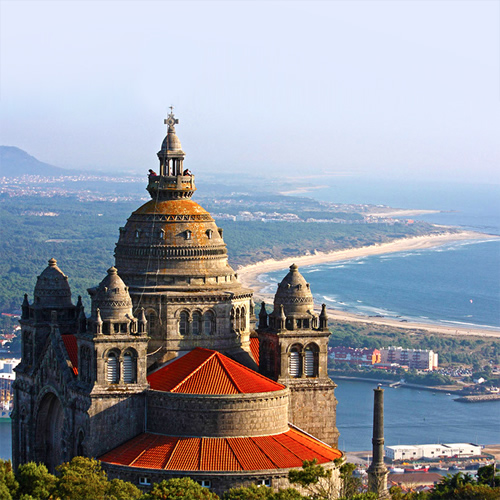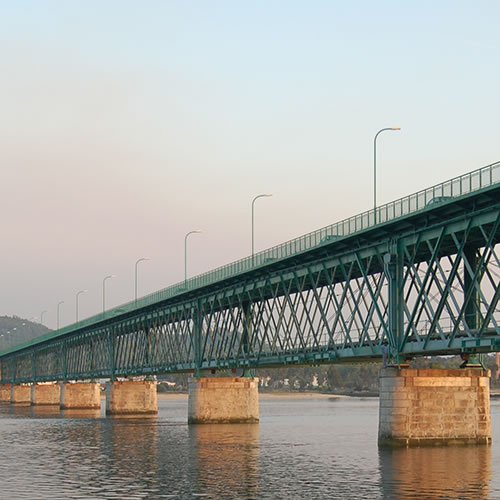Day 1 in Viana do Castelo
Welcome to Viana do Castelo! Upon arrival in Portugal, you will go through customs and immigration. Should you opt to purchase a transfer to your hotel; a representative will be waiting for you as you exit immigration. Arrive at your hotel, check in and do not give in to jet lag! There is so much for you to see and do!
Begin your trip to Viana do Castelo by taking the Elevador de Santa Luzia up the hill of the same name to visit one of the most picturesque religious shrines in the country, the Santuario de Santa Luzia. Afterward, take the time to view the Roman ruins of the Citania of Santa Luzia. If you have time, travel to the next town over, Abelheira, where the secluded and hauntingly beautiful monastery Convento de Sao Francisco do Monte is located.

Day 2 in Viana do Castelo
Start bright and early by visiting the Forte da Areosa, one of the many lines of defense in this strategic military town. After you`re done, go to the port and visit the primary defense for Viana do Castelo, the Forte de Santiago da Barra. On the southwestern side of the castle-fort`s grounds, you will be able to see the Statue of the Mulher Vianesa, a new and thoughtful addition to the points of interest in town.
Head down Rua Alves Cerqueira and visit the Monument to Freedom, built 25 years after the Carnation Revolution, and made by the same sculptor and artist who designed the Mulher Vianesa statue. In the same area, you can tour the Navio Gil Eannes, a former Navy hospital ship which is now a history museum. On the nearby Alameda 5 de Outubro, there is a statue dedicated to Viana do Castelo, erected hundreds of years ago to celebrate the city`s seafaring history. In the distance you can see the Ponte Eiffel, conceptualized by Gustave Eiffel who also designed Paris`s Eiffel Tower.
Now head into the historic city center and have lunch on the Praca da Republica. You can view a number of historic buildings on the square, including the Hospital Velho, the Igreja da Misericordia, and the Antigos Pacos de Concelho (the old city hall building). At the other end of the plaza is the Museu do Traje, a museum which tells the history of Viana do Castelo through artifacts such as folk costumes. On the next street over, Rua Sacadura Cabral, you can see the stately Viana do Castelo Cathedral, which stands next to another noteworthy structure, the Casa dos Arcos, where the town priests once lived.
End the day by studying some more religious architecture, such as the Convento de Santa Ana, built for the local Franciscan friars, as well as its annex, the Igreja de Sao Domingos. Make room for a good stroll around the gardens of the Capela de Nossa Senhora da Agonia, where there are numerous shrines and chapels featuring ornate altarpieces.



Day 3 in Viana do Castelo
Drive or hire transportation to head 30 miles to the east, and to Peneda-Geres National Park, the only area designated as a national park in all of Portugal. There you can view such marvels as the mountain pass called the Portela do Homem, straddling the border with Spain. Four miles southwest of the Portela do Homem sits the ruins of Vilarinho da Furna, a village flooded by the creation of a dam in 1972. When the water levels are low, you can see the remnants of houses and other buildings.
Return to the Viana do Castelo area and take the ferry over to Praia do Cabedelo for a fun afternoon at the beach. Praia do Cabedelo is considered one of the best beaches in the north of Portugal, and it is a great place to swim and enjoy water sports.


Additional Days in Viana do Castelo
North of Vilarinho da Furna and the Portela do Homem by about thirteen miles is the small village of Peneda, home of one of northern Portugal`s most noteworthy pilgrimage spots, the Santuario da Nossa Senhora da Peneda. The shrine dedicated to Our Lady of Peneda is the site of a massive pilgrimage which brings thousands to the secluded grounds in the first week of September every year. At the front of the church, there is a `staircase of virtues`, with statues out front representing faith, hope, charity and glory. Then there is a green space with 20 chapels, leading to a pillar located inside the area where the chapels were built; the pillar was donated and blessed by Queen Maria I (1734-1816).
Before you head home, consider a leisurely stay in Porto, the country`s second-largest city. `The Invincible City,` as it is nicknamed, is one of the oldest European cities, having been conquered by the Celts, the Romans and the Moors, all before the 11th century. The city`s long history is evident when you stroll the winding back streets of the city center, which was named a UNESCO World Heritage Site in 1996. Porto, the second-largest city in Portugal, is also a hub for shopping, music, art, entertainment, and culture for the north of the country. Enjoy a Francesinha (a Porto delicacy!) and a cha (tea) at the numerous cafes around town; see some of the breathtaking architecture and history at sights like the Porto Cathedral, Porto City Hall, and the Muralha Fernandina; shop for hours at the shops in Baixa and Cedofeita; and sample a glass or two of delicious port wine (the area around Porto is world-renowned for its port!).


Your Last Day in Viana do Castelo
Depart your hotel for the airport for your return home. We recommend that you purchase a private transfer; if so, a representative will meet you at the hotel in time to take you to the airport for your flight out.
